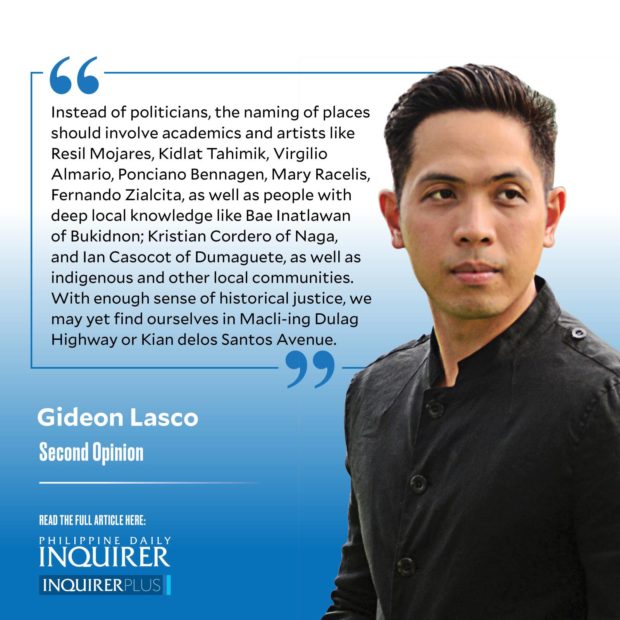On naming places after people
Two of last year’s developments inspired this piece: the proposal to rename Ninoy Aquino International Airport after Ferdinand E. Marcos (House Bill No. 610), and the proposal to name a state university in Ilocos Norte, likewise after the late dictator (HB 2407).
Such moves are clear acts of congressional obsequiousness, and they are nothing new. We are paying Congress to come up with ideas and bills to change the country for the better, and while some lawmakers rise to the challenge, many others are content to indulge with such trivialities. I hope our economists calculate how much time—and taxpayer’s money—is wasted on naming and renaming places, from roads and bridges, to schools and even entire municipalities.
Article continues after this advertisementWhat is even more scandalous is the fact that some of them, not content to waste their position this way, have the shamelessness to name those places (and entire geographic areas) after themselves, their family members, and patrons, in effect serving as the ultimate form of “epal-ness.” On a recent 100-kilometer bike ride around Taal Lake, for instance, I saw various school buildings named after local politicians.
On one level, we can debate whether Marcos or Aquino deserved the honor of having different places named after them. We can also criticize Congress for dwelling on nomenclature, as I have done above. But we can take this issue to a deeper level and ask ourselves: Must we name places after people in power?
—————–
Article continues after this advertisementIn the past, people named places based on the inherent characteristics of the place itself, not in honor of other people. Thus, Manila comes from “may-nilà,” meaning “where indigo is found”; Iloilo is supposedly derived from “irong-irong”—“like a nose”—to describe the shape of Iloilo River. Lipa, for its part, is said to be named after the poisonous wood nettle (Dendrocnide meyeniana) that I try to avoid in my hikes.
Perhaps the act of naming a place after something that is external to the place itself began with colonization, and the earliest examples in the Philippines include Ferdinand Magellan’s “Las Islas de San Lázaro” to Ruy López de Villalobos’ “Las Islas Filipinas.” Eventually, many places in the country became up for grabs as a way to honor various sinners and saints, including places that we don’t even know are named after a person, like Marikina and Alaminos (both the city in Pangasinan and the town in Laguna), all of which are named after Spanish governors general.
Which is to say that there is something colonial about the naming of places after something that is extrinsic to it. To name a place is to displace the primacy of its inherent character in giving meaning to it, and in doing so, colonize its very identity; to rename it is to deny the significance of a culture with which it was, or is, intimately linked.
Consequently, renaming a place has decolonizing potential. This is the reason why countries have changed their names and Marcos himself, in an act of self-serving nationalism, tried to rename “Filipinas” to a term that, regardless of its precolonial significance, haunts us today: Maharlika.
We need to recover the names, whenever available, of places, to remind ourselves of what once was and what can be. Can we not have more streets that pay tribute to our cultural, biological, and historical diversity? Children’s writer Candy Gourlay once told me that “we should put up a statue of a rhinoceros in Manila to remind ourselves that such an animal once roamed in Luzon.” Short of such an intriguing suggestion—one I heartily endorse—might names also help revive bygone eras in our consciousness?
Of course, we should continue to honor people by naming places after them—and this is especially for new constructions—airports, subway stations, dedicated bike lanes, and walkways. But they should honor not just political figures (or rich people who can donate enough money to get entire colleges or institutes named after themselves), but people from all walks of life.
For this reason, instead of politicians, the naming of places should involve academics and artists like Resil Mojares, Kidlat Tahimik, Virgilio Almario, Ponciano Bennagen, Mary Racelis, Fernando Zialcita, as well as people with deep local knowledge like Bae Inatlawan of Bukidnon; Kristian Cordero of Naga, and Ian Casocot of Dumaguete, as well as indigenous and other local communities.
With enough sense of historical justice, we may yet find ourselves in Macli-ing Dulag Highway or Kian delos Santos Avenue.
—————–
glasco@inquirer.com.ph

















